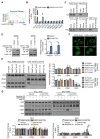LincRNA01703 Facilitates CD81+ Exosome Secretion to Inhibit Lung Adenocarcinoma Metastasis via the Rab27a/SYTL1/CD81 Complex
- PMID: 38136327
- PMCID: PMC10742068
- DOI: 10.3390/cancers15245781
LincRNA01703 Facilitates CD81+ Exosome Secretion to Inhibit Lung Adenocarcinoma Metastasis via the Rab27a/SYTL1/CD81 Complex
Abstract
Metastasis, a major cause of cancer-related mortality worldwide, frequently occurs early in the diagnosis of lung adenocarcinoma (LUAD). However, the precise molecular mechanisms governing the aggressive metastatic behavior of LUAD remain incompletely understood. In this study, we present compelling evidence indicating that the long noncoding RNA linc01703 is significantly downregulated in metastatic lung cancer cells. Intriguingly, in vivo experiments revealed that Linc01703 exerted a profound inhibitory effect on lung cancer metastasis without discernible impact on the in vitro proliferation or invasion capacities of LUAD cells. Mechanistically, Linc01703 enhanced the interaction between Rab27a, SYTL1, and CD81, consequently promoting the secretion of CD81+ exosomes. These exosomes, in turn, suppressed the infiltration of immune cells within the tumor microenvironment, thereby impeding LUAD metastasis. Importantly, our analysis of lung cancer tissues revealed a correlation between reduced CD81 expression and an unfavorable patient prognosis. Collectively, our findings suggest that Linc01703 functions as a metastasis suppressor by facilitating the secretion of CD81+ exosomes through the formation of the Rab27a/SYTL1/CD81 complex.
Keywords: CD81; exosomes; long noncoding RNA; lung cancer; metastasis.
Conflict of interest statement
The authors declare no conflict of interest.
Figures






References
Grants and funding
- No. GDNRC [2022]35/the Funding on Guangdong Marine Economy Development Special Project
- 81820108025/the Natural Science Foundation of China
- 82030088/the Natural Science Foundation of China
- 82073050/the Natural Science Foundation of China
- 2023A1515010289/the Natural Science Foundation of Guangdong Province
LinkOut - more resources
Full Text Sources

